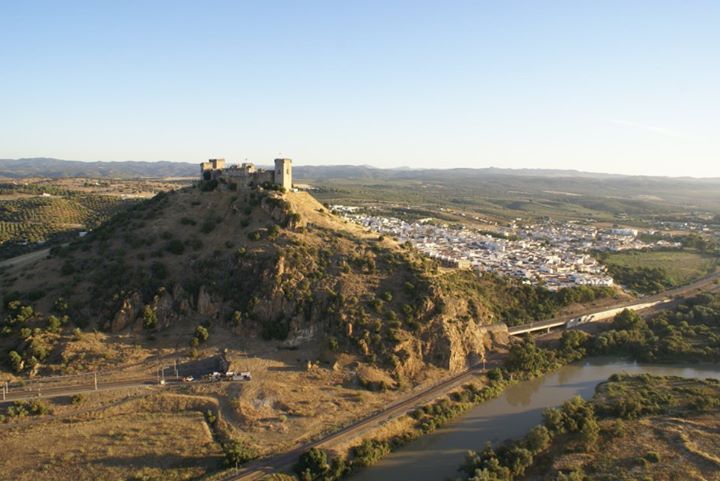Almodóvar del Río

The town is located between the Guadalquivir river plain, where most of its territory lies on fertile agricultural land, and the mountain range which is part of the Sierra de Hornachuelos Nature Reserve, the largest protected space in the province. This is an area of great scenic value, populated with cork oaks, holm oaks and scrubland, as well as containing riverbank forests of willows, ash and alder. It also has a very rich fauna and is an important game reserve. There are various areas which are ideal for nature excursions, such as the La Breña reservoir on the Guadiato river, and a very interesting route along the banks of the Guadalquivir where visitors can enjoy the riverbank forests.
The town is an urban cluster of narrow streets with white houses in the popular local architectural style, spreading out around the base of an imposing castle, which is still in a magnificent state of conservation and offers outstanding views over the town and the river plain.
History
A river, the Guadalquivir, and a hill, El Redondo, were the early keys to the development of this village, creating conditions favorable to the establishment of human settlements since time immemorial.
There have been settlers in this spot since the lower Paleolithic era, as attested by the archaeological site on the banks of the Guadalquivir, which contained the oldest tools made by man, known as the "carved stones".
Its privileged geographic situation has made this place home to numerous different cultures, all of whom have left traces of their presence in the surrounding area. The hill and its castle have witnessed the passage of all these civilizations, as shown by the Neolithic, Iberian, Roman, Visigoth and Arab remains found on the site.
On the site where Almodóvar stands today there was an Iberian-Turdetani settlement, and this is generally identified with the "Carbula" mentioned in a passage by Pliny (the Roman geographer). Carbula was an oppidum –or fortified town- and is thought to have been quite well known as it may have served as a loading point for products from the surrounding agricultural areas. A considerable pottery industry grew up around these trading activities, and silver was possibly mined nearby; they even issued their own currency in the 2nd century B.C. With the arrival of the Romans, the town was integrated into the colonial territory of Cordoba. Most of the population at this time was scattered throughout the numerous villages dotted around the Guadalquivir Valley.
The Muslim period was also a time of great development for the area; it had control of the navigable Guadalquivir river and of the road from Cordoba to Seville. In 740, the Arabs built a fortress they called Al-Mudawvar (round or safe) which is the origin of the name of the town which would grow up in its shadow. The chronicles of the Muslim conquest mention the town in that year, when the Caliph of Damascus designated the lord of Almodóvar, Abd al-Malik ben Qatan, to occupy for the second time the emirate of al-Andalus, a post which he held until his death in the civil war against the Syrians. During the 8th, 9th and 10th centuries the fortress and its dominions formed part of the province of Cordoba. In the 11th century it became part of the taifa, or Muslim kingdom, of Carmona, and then of the taifa of Seville, until it once again rejoined the jurisdiction of Cordoba under the Almoravids, and finally became a dependency of the Almohad court of Seville in the 12th century.
For five centuries the town had been linked to Islamic Spain, until in 1240 Ferdinand III made a pact to incorporate it into the dominions of the Spanish crown. Three years later it was presented to the Council of Cordoba.
The boundaries between Almodóvar and Posadas were established under King Alfonso X.
In 1360, Pedro I lodged in its castle, as did Enrique II on numerous occasions.
Almodóvar Castle was owned in the 15th century by the Baena and Cabra family.
Throughout the 16th and 17th centuries, the issue of the nobility took on unusual significance in the lands around Cordoba.
The town of Almodóvar and its castle served as security for the purchase of Fuente Obejuna in 1513, and returned to the hands of the crown. The town had its own independent jurisdiction, with ties to the city of Cordoba, until Philip IV approved the sale of Almodóvar in 1629. It was bought by Don Francisco del Corral y Guzmán, a knight of the Order of Santiago, and the town thus became a noble dominion, in which the power and justice were administered in the name of its lord.
This town has been witness to the key events of the two last centuries, including the Peninsular Wars, the sale of church lands by Mendizábal –which led to the consolidation of one vast property–, and finally in the 20th century, it saw the great organising capacity of the peasant movement during the Second Republic, the Spanish Civil War, and the mass emigration of its citizens in the 70s.

- Max 35
- Min 31
- Max 95
- Min 87
- °C
- °F












